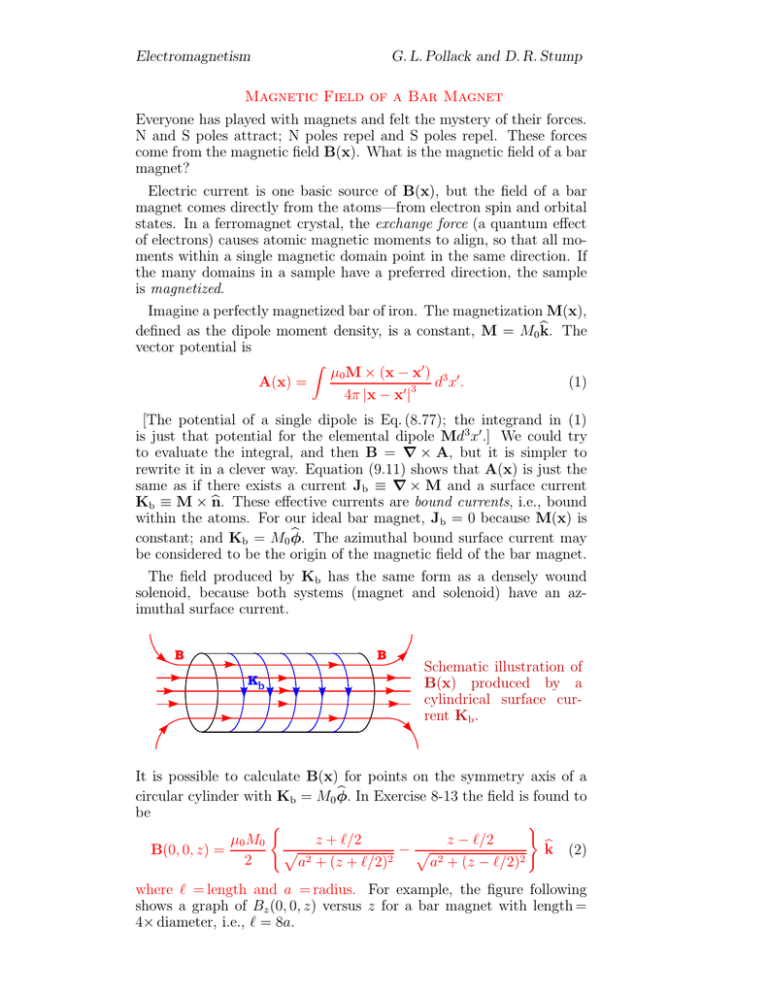Electromagnetism GL Pollack and DR Stump Magnetic Field of a Bar
advertisement

Electromagnetism G. L. Pollack and D. R. Stump Magnetic Field of a Bar Magnet Everyone has played with magnets and felt the mystery of their forces. N and S poles attract; N poles repel and S poles repel. These forces come from the magnetic field B(x). What is the magnetic field of a bar magnet? Electric current is one basic source of B(x), but the field of a bar magnet comes directly from the atoms—from electron spin and orbital states. In a ferromagnet crystal, the exchange force (a quantum effect of electrons) causes atomic magnetic moments to align, so that all moments within a single magnetic domain point in the same direction. If the many domains in a sample have a preferred direction, the sample is magnetized. Imagine a perfectly magnetized bar of iron. The magnetization M(x), b The defined as the dipole moment density, is a constant, M = M0 k. vector potential is Z µ0 M × (x − x0 ) 3 0 A(x) = d x. (1) 4π |x − x0 |3 [The potential of a single dipole is Eq. (8.77); the integrand in (1) is just that potential for the elemental dipole Md3 x0 .] We could try to evaluate the integral, and then B = ∇ × A, but it is simpler to rewrite it in a clever way. Equation (9.11) shows that A(x) is just the same as if there exists a current Jb ≡ ∇ × M and a surface current b . These effective currents are bound currents, i.e., bound Kb ≡ M × n within the atoms. For our ideal bar magnet, Jb = 0 because M(x) is b The azimuthal bound surface current may constant; and Kb = M0 φ. be considered to be the origin of the magnetic field of the bar magnet. The field produced by Kb has the same form as a densely wound solenoid, because both systems (magnet and solenoid) have an azimuthal surface current. B B Kb Schematic illustration of B(x) produced by a cylindrical surface current Kb . It is possible to calculate B(x) for points on the symmetry axis of a b In Exercise 8-13 the field is found to circular cylinder with Kb = M0 φ. be ( ) z + `/2 z − `/2 µ0 M 0 b (2) p −p k B(0, 0, z) = 2 a2 + (z + `/2)2 a2 + (z − `/2)2 where ` = length and a = radius. For example, the figure following shows a graph of Bz (0, 0, z) versus z for a bar magnet with length = 4× diameter, i.e., ` = 8a. solenoid length B(z)/B0 0.8 0.6 0.4 0.2 -5 -4 -3 -2 -1 z/a 1 2 3 4 5 Examples • For z `, i.e., far from the magnet, the field is Bz (0, 0, z) ∼ µ0 m 2πz 3 where m = M0 πa2 `. (3) (The asymptotic expansion from (2) is nontrivial!) This is the field of a magnetic dipole with dipole moment m = MΩ where Ω = πa2 ` is the volume of the magnet. A graph of Bz from (2) on a log scale will reveal that Bz ∝ z −3 asymptotically. • If ` a, then the field at the center of the bar magnet is b B(0, 0, 0) = µ0 M0 k, (4) and the field at the end is 1 b B(0, 0, `/2) = µ0 M0 k. 2 For magnetized iron, µ0 M0 is of order 1 T. (5)


